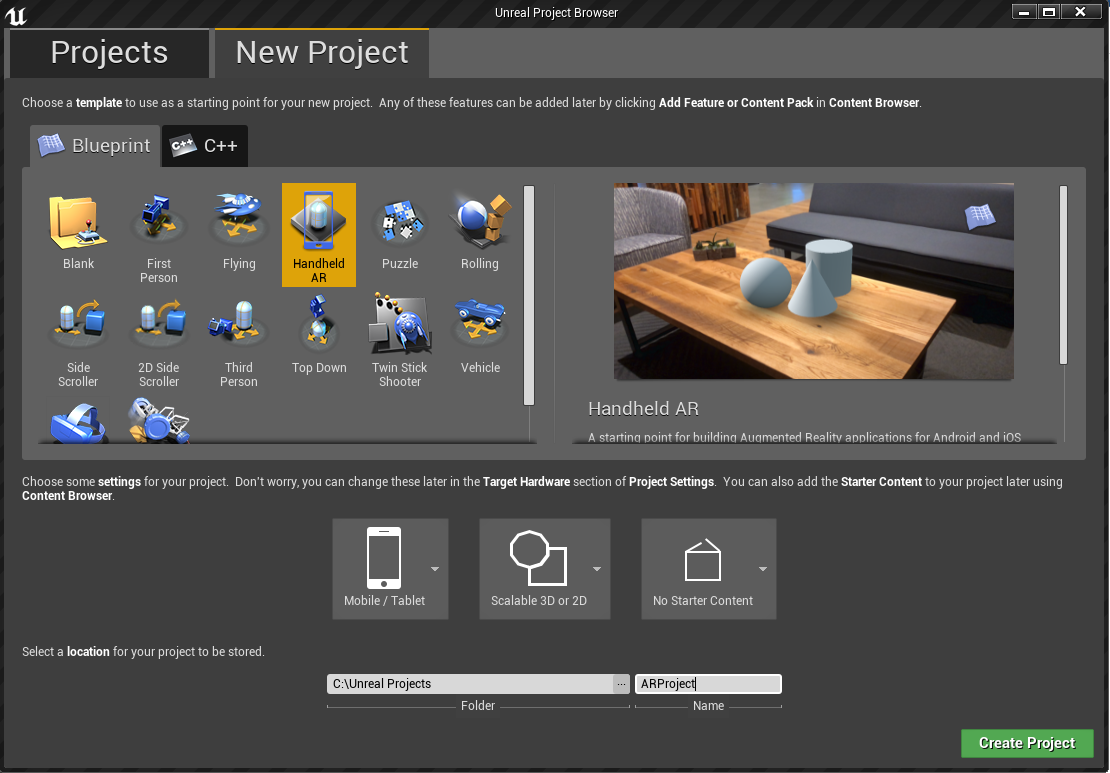 For those developers not interested in AR, Unreal Engine 4.19 provides all sorts of other updated goodies. For example, there’s a new upscaling method called Temporal Upscale, support for Dynamic Resolution (“adjusts the resolution as needed to achieve a desired framerate, for games on PlayStation 4 and Xbox One”), Physical Light Units, and improvements to character and landscape rendering. If that wasn’t enough, Unreal content that supports SteamVR is now compatible with HTC’s Vive Pro headset, and there have been upgrades to various platform SDKs. The timing of this rollout is interesting. At the beginning of March, IBM and Unity (the other popular game-development platform) announced an open-source SDK for natural-language processing, which could enable game developers to build spoken-word support into their AR and virtual reality (VR) games. And over the next few months, both Apple and Google will surely roll out improvements to their respective AR-development platforms (ARKit and ARCore) at their huge annual conferences. By unveiling a unified AR development platform, Unreal is trying to position itself as an ideal solution for AR games and apps in an increasingly crowded market. Unreal has certain advantages in this fight, including a huge install base among game developers. The big question is whether AR developers will gravitate toward a unified platform, or choose to stick with specific tools for iOS and Android; as with so much software, ease-of-use will help determine the Unified Unreal Augmented Reality Framework’s adoption rate.
For those developers not interested in AR, Unreal Engine 4.19 provides all sorts of other updated goodies. For example, there’s a new upscaling method called Temporal Upscale, support for Dynamic Resolution (“adjusts the resolution as needed to achieve a desired framerate, for games on PlayStation 4 and Xbox One”), Physical Light Units, and improvements to character and landscape rendering. If that wasn’t enough, Unreal content that supports SteamVR is now compatible with HTC’s Vive Pro headset, and there have been upgrades to various platform SDKs. The timing of this rollout is interesting. At the beginning of March, IBM and Unity (the other popular game-development platform) announced an open-source SDK for natural-language processing, which could enable game developers to build spoken-word support into their AR and virtual reality (VR) games. And over the next few months, both Apple and Google will surely roll out improvements to their respective AR-development platforms (ARKit and ARCore) at their huge annual conferences. By unveiling a unified AR development platform, Unreal is trying to position itself as an ideal solution for AR games and apps in an increasingly crowded market. Unreal has certain advantages in this fight, including a huge install base among game developers. The big question is whether AR developers will gravitate toward a unified platform, or choose to stick with specific tools for iOS and Android; as with so much software, ease-of-use will help determine the Unified Unreal Augmented Reality Framework’s adoption rate. Unreal Engine Pushes Hard into Augmented Reality
The latest update to the Unreal Engine (4.19) is going all-in on augmented reality (AR). That’s big news for the developers and tech pros who rely on Unreal to create games and applications, and who might be interested in exploring how they can port their work into an AR environment. Unreal’s Unified Unreal Augmented Reality Framework (go ahead, say that five times fast) is positioned as a unified framework for iOS and Android AR apps. “The framework provides a single path of development, allowing developers to build AR apps for both platforms using a single code path,” read Unreal’s blog posting on the matter. “The Unified Unreal AR Framework includes functions supporting Alignment, Light Estimation, Pinning, Session State, Trace Results, and Tracking.” There’s also an AR-based project template, complete with an example project that details all aspects of Unreal’s AR functionality:  For those developers not interested in AR, Unreal Engine 4.19 provides all sorts of other updated goodies. For example, there’s a new upscaling method called Temporal Upscale, support for Dynamic Resolution (“adjusts the resolution as needed to achieve a desired framerate, for games on PlayStation 4 and Xbox One”), Physical Light Units, and improvements to character and landscape rendering. If that wasn’t enough, Unreal content that supports SteamVR is now compatible with HTC’s Vive Pro headset, and there have been upgrades to various platform SDKs. The timing of this rollout is interesting. At the beginning of March, IBM and Unity (the other popular game-development platform) announced an open-source SDK for natural-language processing, which could enable game developers to build spoken-word support into their AR and virtual reality (VR) games. And over the next few months, both Apple and Google will surely roll out improvements to their respective AR-development platforms (ARKit and ARCore) at their huge annual conferences. By unveiling a unified AR development platform, Unreal is trying to position itself as an ideal solution for AR games and apps in an increasingly crowded market. Unreal has certain advantages in this fight, including a huge install base among game developers. The big question is whether AR developers will gravitate toward a unified platform, or choose to stick with specific tools for iOS and Android; as with so much software, ease-of-use will help determine the Unified Unreal Augmented Reality Framework’s adoption rate.
For those developers not interested in AR, Unreal Engine 4.19 provides all sorts of other updated goodies. For example, there’s a new upscaling method called Temporal Upscale, support for Dynamic Resolution (“adjusts the resolution as needed to achieve a desired framerate, for games on PlayStation 4 and Xbox One”), Physical Light Units, and improvements to character and landscape rendering. If that wasn’t enough, Unreal content that supports SteamVR is now compatible with HTC’s Vive Pro headset, and there have been upgrades to various platform SDKs. The timing of this rollout is interesting. At the beginning of March, IBM and Unity (the other popular game-development platform) announced an open-source SDK for natural-language processing, which could enable game developers to build spoken-word support into their AR and virtual reality (VR) games. And over the next few months, both Apple and Google will surely roll out improvements to their respective AR-development platforms (ARKit and ARCore) at their huge annual conferences. By unveiling a unified AR development platform, Unreal is trying to position itself as an ideal solution for AR games and apps in an increasingly crowded market. Unreal has certain advantages in this fight, including a huge install base among game developers. The big question is whether AR developers will gravitate toward a unified platform, or choose to stick with specific tools for iOS and Android; as with so much software, ease-of-use will help determine the Unified Unreal Augmented Reality Framework’s adoption rate.
 For those developers not interested in AR, Unreal Engine 4.19 provides all sorts of other updated goodies. For example, there’s a new upscaling method called Temporal Upscale, support for Dynamic Resolution (“adjusts the resolution as needed to achieve a desired framerate, for games on PlayStation 4 and Xbox One”), Physical Light Units, and improvements to character and landscape rendering. If that wasn’t enough, Unreal content that supports SteamVR is now compatible with HTC’s Vive Pro headset, and there have been upgrades to various platform SDKs. The timing of this rollout is interesting. At the beginning of March, IBM and Unity (the other popular game-development platform) announced an open-source SDK for natural-language processing, which could enable game developers to build spoken-word support into their AR and virtual reality (VR) games. And over the next few months, both Apple and Google will surely roll out improvements to their respective AR-development platforms (ARKit and ARCore) at their huge annual conferences. By unveiling a unified AR development platform, Unreal is trying to position itself as an ideal solution for AR games and apps in an increasingly crowded market. Unreal has certain advantages in this fight, including a huge install base among game developers. The big question is whether AR developers will gravitate toward a unified platform, or choose to stick with specific tools for iOS and Android; as with so much software, ease-of-use will help determine the Unified Unreal Augmented Reality Framework’s adoption rate.
For those developers not interested in AR, Unreal Engine 4.19 provides all sorts of other updated goodies. For example, there’s a new upscaling method called Temporal Upscale, support for Dynamic Resolution (“adjusts the resolution as needed to achieve a desired framerate, for games on PlayStation 4 and Xbox One”), Physical Light Units, and improvements to character and landscape rendering. If that wasn’t enough, Unreal content that supports SteamVR is now compatible with HTC’s Vive Pro headset, and there have been upgrades to various platform SDKs. The timing of this rollout is interesting. At the beginning of March, IBM and Unity (the other popular game-development platform) announced an open-source SDK for natural-language processing, which could enable game developers to build spoken-word support into their AR and virtual reality (VR) games. And over the next few months, both Apple and Google will surely roll out improvements to their respective AR-development platforms (ARKit and ARCore) at their huge annual conferences. By unveiling a unified AR development platform, Unreal is trying to position itself as an ideal solution for AR games and apps in an increasingly crowded market. Unreal has certain advantages in this fight, including a huge install base among game developers. The big question is whether AR developers will gravitate toward a unified platform, or choose to stick with specific tools for iOS and Android; as with so much software, ease-of-use will help determine the Unified Unreal Augmented Reality Framework’s adoption rate. 


